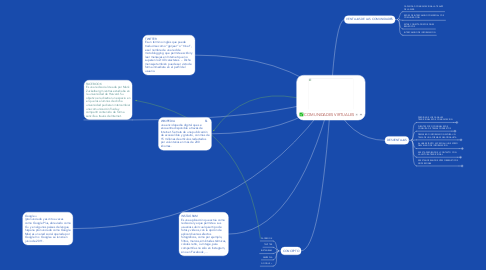
1. INSTAGRAM Es una aplicación que actúa como red social ya que permite a sus usuarios subir cualquier tipo de fotos y videos, con la opción de aplicar diversos efectos fotográficos, como por ejemplo, filtros, marcos, similitudes térmicas, colores retro, o vintage, para compartirlas no sólo en Instagram, sino en Facebook, ...
2. CONCEPTO
2.1. FACEBOOK
2.2. TWITTER
2.3. INSTAGRAM
2.4. WIKIPEDIA
2.5. GOOGLE +
3. FACEBOOK Es una red social creada por Mark Zuckerberg mientras estudiaba en la universidad de Harvard. Su objetivo era diseñar un espacio en el que los alumnos de dicha universidad pudieran intercambiar una comunicación fluida y compartir contenido de forma sencilla a través de Internet.
4. TWITTER Es un término inglés que puede traducirse como “gorjear” o “trinar”, es el nombre de una red de microblogging que permite escribir y leer mensajes en Internet que no superen los 140 caracteres. ... Dicho mensaje también puede ser visto de forma inmediata en el perfil del usuario.
5. WIKIPEDIA Es una enciclopedia digital que se encuentra disponible a través de Internet. Se trata de una publicación de acceso libre y gratuito, con más de 15 millones de artículos redactados por voluntarios en más de 200 idiomas.
6. Google+ (pronunciado y escrito a veces como Google Plus, abreviado como G+ y en algunos países de lengua hispana pronunciado como Google Más) es una red social operada por Google Inc. Google+ se lanzó en junio de 2011.
7. VENTAJAS DE LAS COMUNIDADES
7.1. CAPACIDAD COMUNICACIONAL A TRAVEZ DE LA WEB
7.2. REDES DE INTERCAMBIO COMERCIAL Y DE COMUNICACION
7.3. ESTAR CONECTADOS POR FINES BENEFICOS
7.4. INTERCAMBIO DE INFORMACION
8. DESVENTAJAS
8.1. PERDIDA DE LOS CANALES TRADICIONALES DE COMUNICACION
8.1.1. Service Offer
8.1.1.1. What are we selling?
8.1.1.2. Product Definition
8.1.1.3. Pricing
8.1.1.4. Packaging
8.1.1.5. Positioning
8.1.2. Value Proposition
8.1.2.1. What is the Value Proposition to the Customer?
8.1.2.2. What pain are we solving?
8.2. FUENTES POCO CONFIABLES DE CONSULTA DE TEMAS CONCRETOS
8.2.1. Revenue Forecasts
8.2.1.1. Revenue and P&L Forecast (5 Years)
8.2.1.2. Revenue should be split out quarterly
8.2.2. Cost Analysis
8.2.2.1. Should include a description of the costs in entering this business and profitability analysis
8.2.3. Profitability Analysis
8.2.3.1. P&L for the offer to include gross margin, net income and break even analysis.
8.3. DEMASIADO INFORMACION SATURA UN TEMA DE UNA FORMA SENSACIONALISTA
8.3.1. Sales Strategy
8.3.1.1. Direct Sales Strategy
8.3.1.2. Inside Sales Strategy
8.3.1.3. Channel Sales Strategy
8.3.2. Partner Strategy
8.3.2.1. Channel Strategy
8.3.2.1.1. What 3rd party channels should we consider for reselling this service?
8.3.2.2. Technology Partnerships
8.3.2.2.1. What technology vendors (if any) do we need to work with to execute on this plan?
8.3.2.3. Solutions Partners
8.4. AL HABER TANTO ACCESO AHI UN EXCESO DESVELADO DE INFORMACION
8.4.1. Positioning & Messaging
8.4.1.1. What is the key messaging and positioning for the service offer? (Pain, alternatives, solution)
8.4.1.2. How do we communicate internally?
8.4.1.3. How do we communicate externally?
8.4.2. Promotion Strategy
8.4.2.1. Marketing Programs (Installed base versus new prospects)
8.4.2.2. Advertising (Publications, etc.)
8.4.2.3. Analyst Relations (Target Analysts)
8.4.2.4. Public Relations
8.4.2.5. Events (Trade shows, SEO/SEA, Seminars)
8.4.2.6. Webinars
8.4.3. Demand Generation & Lead Qualification
8.4.3.1. How do we generate and qualify new leads for the target offer?
8.4.3.2. Prospect Lists
8.4.3.3. Key Questions to Ask
8.4.3.4. Sales Collateral
8.4.3.5. Presentations
8.4.3.6. Data Sheets
8.4.3.7. White Papers
8.4.3.8. ROI Tools
8.4.3.9. Other Sales Tools (web site, etc.)
8.5. SE ESTA PERDIENDO EL CONTACTO CON LA LECTURA TRADICIONAL
8.5.1. Numbers, budget, waterfall, break-even (cost>leads>trials>deals)
8.5.2. Sales Programs
8.5.3. Accelerated Learning Strategy, Controls, Metrics
8.5.4. Include feedback loops
8.5.5. Include financial metrics (definition of success)
8.5.6. Pipeline reports, etc…
8.6. SE ESTAN CREANDO ENTES CIBERNETICOS NO PERSONAS
8.6.1. M&A?
8.6.2. Risk Analysis & Mitigation
